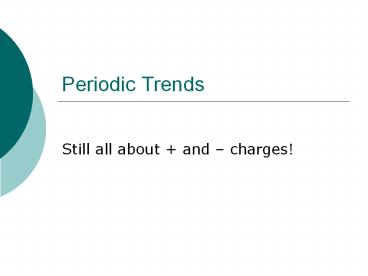Periodic Trends - PowerPoint PPT Presentation
Title:
Periodic Trends
Description:
Periodic Trends Still all about + and charges! Electron Affinity Electron Affinity is complementary to ionization energy. Rather than give up an electron, the ... – PowerPoint PPT presentation
Number of Views:266
Avg rating:3.0/5.0
Title: Periodic Trends
1
Periodic Trends
- Still all about and charges!
2
Which of the following atoms is the largest?
- Mg
- Ca
- Sr
- How the fluorine should I know?
3
(No Transcript)
4
Which of the following atoms is the largest?
- Mg
- Al
- Cl
5
(No Transcript)
6
Periodic for a Reason
- It is a periodic table because of the periodic
trends that make it up. - We saw that the electron configurations are
periodic (s-block, p-block, d-block, etc.) and I
suggested that the Chemistry associated with the
atoms followed the electron configuration.
7
Other Periodic Properties
- Electron configuration isnt the only periodic
trend in the table. - The other important trends are all rationalizable
based on the most important trend atomic size!
8
Atomic Size
- Suppose we want to compare the atomic radius of
two atoms on the periodic table, for example Na
and K. - Which would you think is bigger?
9
(No Transcript)
10
What does an atom look like?
- Bohr Model
11
The Bohr Model
Nucleus
e-
n
p
p
n
e-
n
p
n
e-
So, what determines the size of the atom?
12
The size is determined by
- where the last electron lies.
- So, which is bigger Na or K?
- K it is Na with a whole extra shell of
electrons!
13
(No Transcript)
14
Na vs. K
- Na 1s22s22p63s1
- K 1s22s22p63s23p64s1
- This is a general trend. As you go down a column
in the periodic table, the atomic radius
increases.
15
What about the rows?
- Suppose I ask the same question about Na and Mg
which is larger?
16
(No Transcript)
17
Na vs. Mg
- Na 1s22s22p63s1
- Mg 1s22s22p63s2
- Does this help us any?
- They have the same valence shell (n3). The same
highest orbital (3s). - Does this mean they are the same size? ?
18
Those pesky charges
- What are the differences between Na and Mg?
- One extra electron
- One extra proton
- Does that help?
19
The Bohr Model - Na
20
The Bohr Model - Mg
21
The Bohr Model Na vs. Mg
22
Na vs. Mg
- Same outer shell of the electrons (- charge).
- More charges in nucleus.
- What do you think happens?
- Mg is actually slightly smaller than Na due to
the extra charge in the nucleus pulling the
electrons in closer!
23
Periodic Trend atomic radius
- This pair of observations describes the general
trend of atomic size - Larger as you go down a column (large effect)
- Smaller as you go across the row (small effect)
- Note There are exceptions due to special cases
(1/2 full orbitals, etc.)
24
(No Transcript)
25
Rank from Largest to smallest
- Sn, In, Ga, As
- In Sn As Ga
- In Sn Ga As
- In Ga Sn As
26
Periodic Trend atomic radius
- Both of these trends are related to the charged
species - Larger as you go down a column (more electron
shells adding layers) - Smaller as you go across the row (stronger
attraction between more protons and the outer
electrons)
27
Other Trends
- Understanding the trend in atomic radius and
keeping the charge issues in mind make it easy to
understand and predict some other periodic trends.
28
Ionization Energy
- Ionization energy is the amount of energy
required to remove an electron from an atom - Na energy ? Na e-
- (You simply raise the electron from nvalence to
n8)
29
Ionization Energy
- Na energy ? Na e-
- If you are going to remove an electron, what is
the relevant issue? - Charge what a surprise!
- What Charge?
- The nuclear charge! - At least in part
30
Na vs. Mg
- Compare the Ionization Energy of Na to that of
Mg. - Which do you think would be larger?
- Na or Mg
- Why?
- They have the same outer orbital, but Mg has a
larger nuclear charge (sound familiar) Mg
should have the larger ionization energy!
31
Larger Ionization Energy
- Sodium
- Magnesium
- I have no frigging idea
32
Na vs. K
- Compare Na to K, what is relevant?
- K is bigger than Na why?
- Because K has more shells and larger radius.
Electrons are farther from nucleus. - Same argument for ionization energy. Electron,
farther away, less attracted to nucleus, smaller
ionization energy!
33
Ionization Energy vs. Atomic Radius
- It is the same arguments, with the same results.
- Ionization energy has a trend that tracks the
radius. Smaller atoms, larger ionization energy!
34
Electron Affinity
- Electron Affinity is complementary to ionization
energy. Rather than give up an electron, the
atom receives it - Na e- ? Na-
- What will determine if an atom wants an electron?
- Attraction for the nucleus so electron affinity
will also track atomic radius
35
Electron Affinity
- Na vs. K
- K will have a smaller electron affinity K is
larger, a new electron is farther away, less
attracted to nucleus - Na vs. Mg
- Na will have a smaller electron affinity same
radius, smaller charge, less attraction for the
electron.
36
(No Transcript)
37
Electronegativity
- Electronegativity is the ability of an atom to
attract electrons to itself. (Kind of like
electron affinity, but on a different scale) - Electronegativity is important in predicting
whether a bond is ionic or covalent. - Electronegativity will have the same trend as
electron affinity.
38
(No Transcript)































